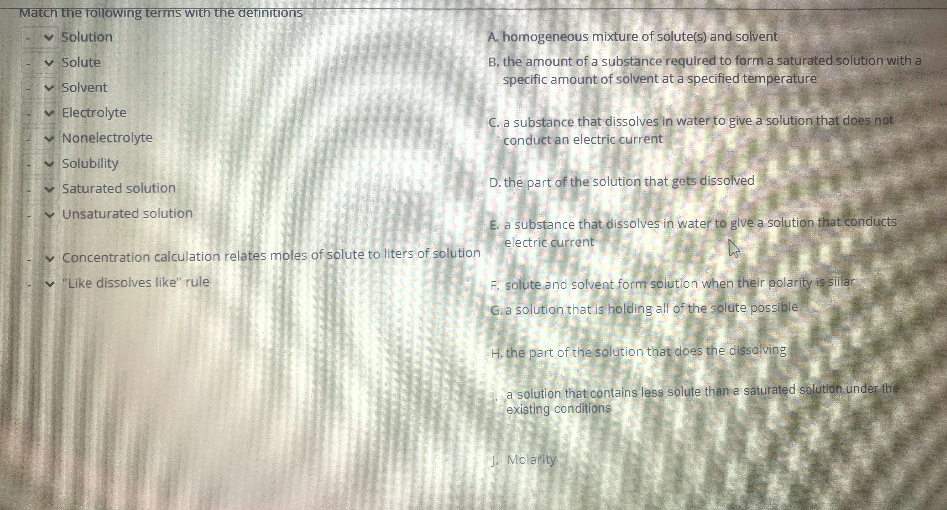Match the following terms with the deTinitions A. homogeneous mixture of solute(s) and solvent B. the amount of a substance required to form a saturated solution with a specific amount of solvent at a specified temperature v Solution v Solute v Solvent v Electrolyte v Nonelectrolyte Solubility C. a substance that dissolves in water to give a solution that does not conduct an electric current v Saturated solution D. the part of the solution that gets dissolved v Unsaturated solution E. a substance that dissolves in water to glve a solution that.conducts electric current Concentration calculation relates moles of solute to liters of solution "Like dissolves like" rule F. solute and solvent form solutlon when their polarity is siilar G.a solution that is holding all of the solute possible H. the part of the solution that does the dissalving a solution that contains less solute than a saturated solution under the existing conditions J. Molarity
Match the following terms with the deTinitions A. homogeneous mixture of solute(s) and solvent B. the amount of a substance required to form a saturated solution with a specific amount of solvent at a specified temperature v Solution v Solute v Solvent v Electrolyte v Nonelectrolyte Solubility C. a substance that dissolves in water to give a solution that does not conduct an electric current v Saturated solution D. the part of the solution that gets dissolved v Unsaturated solution E. a substance that dissolves in water to glve a solution that.conducts electric current Concentration calculation relates moles of solute to liters of solution "Like dissolves like" rule F. solute and solvent form solutlon when their polarity is siilar G.a solution that is holding all of the solute possible H. the part of the solution that does the dissalving a solution that contains less solute than a saturated solution under the existing conditions J. Molarity
Chemistry
10th Edition
ISBN:9781305957404
Author:Steven S. Zumdahl, Susan A. Zumdahl, Donald J. DeCoste
Publisher:Steven S. Zumdahl, Susan A. Zumdahl, Donald J. DeCoste
Chapter11: Properties Of Solutions
Section: Chapter Questions
Problem 27Q
Related questions
Question

Transcribed Image Text:Match the following terms with the deTinitions
A. homogeneous mixture of solute(s) and solvent
B. the amount of a substance required to form a saturated solution with a
specific amount of solvent at a specified temperature
v Solution
v Solute
v Solvent
v Electrolyte
v Nonelectrolyte
Solubility
C. a substance that dissolves in water to give a solution that does not
conduct an electric current
v Saturated solution
D. the part of the solution that gets dissolved
v Unsaturated solution
E. a substance that dissolves in water to glve a solution that.conducts
electric current
Concentration calculation relates moles of solute to liters of solution
"Like dissolves like" rule
F. solute and solvent form solutlon when their polarity is siilar
G.a solution that is holding all of the solute possible
H. the part of the solution that does the dissalving
a solution that contains less solute than a saturated solution under the
existing conditions
J. Molarity
Expert Solution
This question has been solved!
Explore an expertly crafted, step-by-step solution for a thorough understanding of key concepts.
This is a popular solution!
Trending now
This is a popular solution!
Step by step
Solved in 2 steps

Recommended textbooks for you

Chemistry
Chemistry
ISBN:
9781305957404
Author:
Steven S. Zumdahl, Susan A. Zumdahl, Donald J. DeCoste
Publisher:
Cengage Learning


Chemistry: An Atoms First Approach
Chemistry
ISBN:
9781305079243
Author:
Steven S. Zumdahl, Susan A. Zumdahl
Publisher:
Cengage Learning

Chemistry
Chemistry
ISBN:
9781305957404
Author:
Steven S. Zumdahl, Susan A. Zumdahl, Donald J. DeCoste
Publisher:
Cengage Learning


Chemistry: An Atoms First Approach
Chemistry
ISBN:
9781305079243
Author:
Steven S. Zumdahl, Susan A. Zumdahl
Publisher:
Cengage Learning


Principles of Modern Chemistry
Chemistry
ISBN:
9781305079113
Author:
David W. Oxtoby, H. Pat Gillis, Laurie J. Butler
Publisher:
Cengage Learning

Chemistry: Principles and Practice
Chemistry
ISBN:
9780534420123
Author:
Daniel L. Reger, Scott R. Goode, David W. Ball, Edward Mercer
Publisher:
Cengage Learning